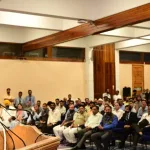The issues of Infertility and high risk pregnancy are emerging as the prime health problems concerning women in the valley. While the experts attribute the issues to delayed marriages, stressful and sedentary lifestyles, the social construct of these problems is perhaps more striking in the case of infertility than other conditions.
To have a detailed view over the issues Rising Kashmir’s Farzana Syed interviews valley’s eminent gynecologist, Professor and former Head of the Department of Obstetrics and Gynecology, Lal Ded hospital, Dr Nighat Firdaus
What are the major reproductive health problems prevalent among women in valley
Infertility, Late conception, Polycystic ovarian disorder, Polycystic ovarian syndrome,High risk pregnancies are some of the reproductive health concerns faced by women folk in Kashmir. In recent years these health concerns have drastically gone up due to numerous reasons associated with them.
What are the reasons inflicting reproductive health concerns on women
Late marriages, sedentary lifestyle, obesity , changing food habits. These form the basis of all health problems women are coping with. Over the years we are witnessing a complete transformation of our lifestyle which is very prominent. Changing lifestyle has inflicted immense stress on our lives. Stress is a major reason behind so many health issues. Other changes such as lack of exercise , more inclination and dependence on junk food, Sleeplessness, which can be attributed to prolonged use of technology. etc have also added to the problems.
How adverse is the impact of a delayed marriage on women’s health
The age of marriages has gone up universally and in all the classes of a society. This has not risen in Kashmir only or India but in the entire world. Therefore there must be something common. With the change in our way of living, other changes are inevitable.
In Kashmir valley the age of marriage has undoubtedly gone up.Be it the upper class or the weaker section of our society, the context of marriage has undergone a gradual but a swath of change. The upper class own numerous reasons for prevalence of late marriages while the weaker sections grapple with their own reasons for delayed marriages.
Socio economically lower sections struggle with numerous issues which have resulted in late marriages. The weaker class suffer from financial problems. On the other hand we are witnessing lavish weddings in the upper class of our society which is resulting in delayed marriages also . Therefore, the notion and the context of marriage has changed, it is no longer limited to marriage of two persons but the evolving socio-cultural indulgence, demands, changing traditions, have changed the very concept of marriage in the valley.
Furthermore, due to financial limitations and evolving rituals and complexities, the weaker sect is not able to afford to marry off their children at a right age.
When the upper class consider marriage, the already delayed process of finding a match gets further complex with numerous twists and turns and stimulati to nuisance of socially constructed norms and conditions . To add to the complexity, the parameter of a girl with higher education and a handsome salary has to be met at all costs no matter how long it is delayed.
Once all the socially set parameters are met, the couple plans the family. We often hear people saying that bearing a child is expensive so let us settle down first. This is how the process of delayed conception hovers on.
Many years back, the age of 24, 25, 26 was a trend for marriages,this was in-fact the right and genuine age. Marriage, after crossing 30s, was irrelevant to the socio-cultural norms of those times. At present that figure has touched 28, 29 oreven 30, in present times this is the age when a family starts to search for a match. .
The already complex process takes 2 to 3 years, till one crosses 30s, once it is done, the condition of getting adjusted comes up.The couple go for settling first before they plan a family. This is how the process stimulates the age related problems developing in a body with the passage of time. Therefore women are getting married late having adversely impacted the conception process. Delayed or late marriage is the major cause of infertility prevalent among women at higher rates. Now we see a huge number of patients who are Elderly primigravida , the term we use for an elderly woman getting pregnant.
How decisive is the age factor for reproductive health issues
As we age our body undergoes a gradual transformation, your body structure changes, your muscle tone changes, reproductive health undergoes a drastic change. When we would do IVF treatments (Invitro Fertility) many years back, the cut of age of a patient was mostly 34 years. At that time we lived up to the notion that egg quality starts deteriorating after 34. However the scenario is completely averse now. Nowadays IVF procedures are done in the 40s also, late 40s even. Now you only need a uterus to carry a baby, nothing else.
What are demand cesareans and how does Elderly Primigravida increase Demand C-Sections
Women get married late which is followed by late conception. They don’t want to take any risk and are eager to have c -section birth as soon as possible. This is a demand cesarean which has gone up . Three are other factors that cause demand c-sections.
It is often asked why don’t doctors counsel patients for normal birth. We do but it is the patient, their family who demand C-Section deliveries.However it is a fact too that c-sections are inevitable in most of the high risk pregnancies.
What are the major reasons behind rise in c-section births
infertility, age, ambition, high risk pregnancy, changing lifestyle, and then demand c-section,these are all factors that have massively added to cesarean births.
Elderly patients getting pregnant , elderly primigravida, late norms of starting family, precious babies. There is one more relevant factor, even today the medical facilities at far flung areas are still not that advanced. By the time a patient is referred to Srinagar and reaches the hospital she is already in a state where you are left with the option to save the mother. In such circumstances the cesarean is done not for the baby but for the mother.
What has led to an increase in high risk pregnancies
High risk pregnancies have gone tremendously up and there are several reasons we attribute the rise to. Medical disorders have gone high, metabolic syndrome is on rise , Polycystic ovarian disorders (PCOD) are increasing, PCOS have risen, Nowadays you see every second girl comes up with PCOD issues.
Sedentary lifestyle, stressful life, and food habits have resulted in these health problems in women.
Metabolic syndrome which is related to PCODs is tremendously on the rise. All these factors are high risk, it makes a patient also high risk. Although diabetes is not an indication of a c-section but for a patient who is elderly, has uncontrolled diabetes, the baby is becoming bigger, the patient is microsomic, elderly age group, patient herself becomes a high risk pregnancy. For high risk pregnancy we have separate clinics such is the risk involved with it. We are seeing so many high risk pregnancies coming in now and most of the high risk pregnancies involve the chances of c-section birth.
What is PCOD, PCOS ? How can we diminish the stigma attached to it ?
PCOD means Polycystic Ovarian Disease while PCOS is polycystic Ovarian syndrome. It starts with disorder (PCOD) which later becomes syndrome with additional problems in ovaries such as hypertension, obesity. At the initial stage it is a disease and it adds to the disease other factors, it becomes a syndrome.The symptoms include irregular periods, infertility, obesity, hair growth.
There is nothing to panic or worry about these issues as it has preventive measures, it has a treatment. Like any other health issue these are also health issues that need to be addressed with timely intervention.
The major causes of PCODs , PCOSs are lifestyle, eating habits, sedentary lifestyle. lack of exercise,lack of proper sleep, fatty liver, obesity.
It is most common among teens . It begins at teenage only. It is more prevalent in urban populations, now that lifestyle is undergoing a change at rural places also, We are seeing patients with PCODs and PCOS there also.
There is a need to create awareness regarding this issue. It should not be stigmatised. There is no stigma attached to it.
PCODs is not a sinister disease it needs to be addressed, For that we need to have awareness at school level, and leave sedentary lifestyle.
What are the advantages of C-Sections? How has advanced medical set-up benefited in antenatal addressal, reducing mortality, morbidity
If we look through a broader spectrum, diagnostic facilities have improved immensely. The ultra sound set-up has improved, colour doppler has advanced, all these have definitely led to decline in mortality rates. C-Sections have increased but the positive part is that we are giving live births. You see, we would lose so many babies in the past.
if we go down to our mothers and our grandmothers, during those times there would be frequent still-births, miscarriages, but that is not happening now at such a high rate. We have advanced ultrasound set-up through which we pick up if there is a growth retardation, if it is a big baby or if there is any other anomaly. In the past so many babies would die due to IUDs, lack of advent.
Therefore we must accept that such medical advancement was not there in the past. me. We don’t take these factors into consideration The advanced technology has helped in declining fetal mortality rates.
Morbidity has decreased, fetal deaths have decreased, We need to see this aspect also when we talk about c-sections.
Medically and diagnostically we have become very advanced. Now we have the fetal medicine which is a part of the fetal well being, the fetal medicine department itself is a separate department now, Earlier there was no way of fetal monitoring, we would only monitor blood pressure, heart rate etc. But now with the advent of modern technical facilities we have fetal monitoring available.,
There are so many fetal anomalies which can be addressed antenatally and then patients can be delivered.
What are the risks involved in C-section birth ?
Cesareans come up with several complications and issues. respiratory distress syndrome can occur in a baby delivered through c-section, grunting is very common, we counsel patients on that too, c-section has its advantages and disadvantages, nobody does it on purpose.
When we statistically see the rate of c-sections the cause is the previous c sections also. if first c section rate gets down the rate would automatically come down,
The c section has anesthesia problems, infection problems, babies’ grunting issues, with proper counselling, proper awareness, no high risk factor. First c section can be avoided, first birth can be normal which would automatically bring down the rate.
for instance suppose you counsel a patient, hear pelvis is normal, her all parameters are normally and then you talk about trial of labour which gets them into phobia
What would be your advice to expecting mothers ?
Try to deliver your first baby normally, if all the parameters are completely normal. avoid unnecessary c-section. Earlier we would say once a csearia not always a cesarean, twice a cesarean always a cesarean. But now it has changed to once a cesarean, always a cesarean, because there is no chance of the second delivery being normal if the first is through a c-section.
We need to create awareness, education regarding this. We should be able to convince the patient that first delivery should be normal,
There is no comparison to delivering a baby normally.





